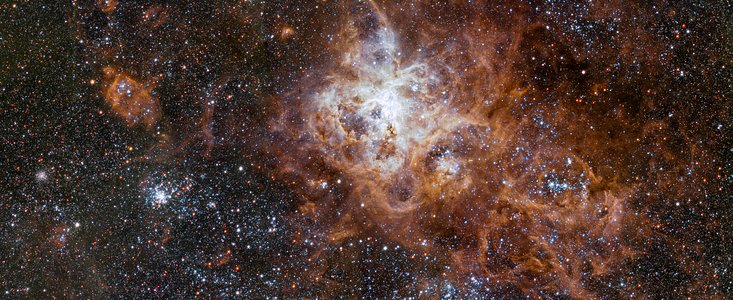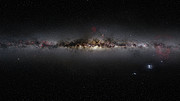Lehdistötiedote
Ahdas naapurusto
30. toukokuuta 2018
Kirkkaana noin 160 000 valovuoden etäisyydellä loistava Tarantellasumu on Linnunradan satelliittigalaksin, Suuren Magellanin pilven näyttävin piirre. Chilessä sijaitseva ESO:n Paranalin observatorion VST-teleskooppi on kuvannut tätä aluetta ja sen runsasta ympäristöä erittäin suurella tarkkuudella. Se paljastaa tähtijoukkojen, hohtavien kaasupilvien ja supernovaräjähdysten hajaantuvien jäännösten kosmisen maiseman. Tämä on tarkin kuva, joka on milloinkaan otettu koko tästä kentästä.
Hyödyntäen Chilessä sijaitsevan, ESO:n Paranalin observatorion VST-teleskoopin (VLT Survey Telescope) ominaisuuksia tähtitieteilijät taltioivat tämän hyvin yksityiskohtaisen uuden kuvan Tarantellasumusta ja sen lukuisista naapurisumuista ja -tähtijoukoista. Myös nimellä 30 Doradus tunnettu Tarantellasumu on kirkkain ja suurienergiaisin tähtienmuodostusalue Paikallisessa galaksiryhmässä.
Tämän kuvan yläosassa näkyvä Tarantellasumu ulottuu yli 1000 valovuoden alueelle ja sijaitsee Kultakalan tähdistössä (Dorado) kaukana eteläisen pallonpuoliskon taivaalla. Tämä upea sumu on osa Suurta Magellanin pilveä, halkaisijaltaan noin 14 000 valovuoden kokoista kääpiögalaksia. Suuri Magellanin pilvi on yksi Linnunrataa lähimmistä galakseista.
Tarantellasumun ytimessä on nuori, jättimäinen tähtijoukko NGC 2070, tähtiryöppyalue, jonka tiheä ydin, R136, sisltää joitakin massiivisimmista ja kirkkaimmista tunnetuista tähdistä. Itse Tarantellasumun kirkkaan hohteen kirjasi ensimmäisenä ylös ranskalainen tähtitieteilijä Nicolas-Louis Lacaille vuonna 1751.
Toinen tähtijoukko Tarantellasumussa on paljon vanhempi Hodge 301, jossa vähintään 40 tähden arvioidaan räjähtäneen supernovina, levittäen kaasua kautta koko alueen. Yksi esimerkki supernovajäänteestä on kuuma kupla SNR N157B, joka sulkee sisäänsä avoimen tähtijoukon NGC 2060. Tätä joukkoa havaitsi ensimmäisenä brittiläinen tähtitieteilijä John Herschel vuonna 1836 käyttäen 18.6 tuuman (47 cm) peilikaukoputkea Hyväntoivonniemellä Etelä-Afrikassa. Tarantellasumun ulkolaitamilla, alhaalla oikealla, on mahdollista tunnnistaa kuuluisan supernovan SN 1987A sijainti [1].
Tarantellasumun vasemmalla puolella on mahdollista nähdä kirkas avoin tähtijoukko NGC 2100, jossa esittäytyy kirkas keskittymä punaisten tähtien ympäröimiä sinisiä tähtiä. Tämän joukon löysi skotlantilainen tähtitieteilijä James Dunlop vuonna 1826 työskennellessään Australiassa, käyttäen itse rakentamaansa 9 tuuman (23 cm) peilikaukoputkea.
Kuvan keskustassa on tähtijoukko ja emissiosumu NGC 2074, joka on toinen massiivinen John Herschelin löytämä tähtienmuodostusalue. Tarkemmin katsoen on mahdollista nähdä tumma merihevosen muotoinen tomurakenne — "Suuren Magellanin pilven merihevonen". Tämä jättimäinen pilarirakenne on noin 20 valovuotta pitkä eli lähes neljä kertaa Auringon ja sitä lähimmän tähden, Alfa Centaurin välinen etäisyys. Rakenne on tuomittu häviämään seuraavan miljoonan vuoden aikana, sillä uusien tähtien muodostuessa tähtijoukossa niiden valo ja tähtituulet puhaltavat hitaasti pois tomupilarit.
Tämä kuva oli mahdollinen vain VST:n erityisesti suunnitellun 256 megapikselin OmegaCAM-kameran ansiosta. Kuva koottiin OmegaCAM-kuvista, jotka otettiin neljällä erivärisellä suotimella — mukaanlukien erityisesti ionisoituneen vedyn punaisen hohteen havaitsemiseen suunniteltu suodin [2].
Lisähuomiot
[1] SN 1987A oli ensimmäinen supernova, jota havaittiin nykyaikaisilla teleskoopeilla ja kirkkain vuonna 1604 nähdyn Keplerin tähden jälkeen. SN 1987A oli niin kirkas, että se loisti 100 miljoonan Auringon teholla useiden kuukausien ajan sen jälkeen, kun se oli löydetty 23. helmikuuta 1987.
[2] H-alfa -emissioviiva on punainen spektriviiva, joka muodostuu, kun vetyatomin sisältämä elektroni menettää energiaa. Tämä tapahtuu vedyssä kuuman, nuoren tähden ympärillä, kun kaasu ionisoituu voimakkaassa ultraviolettisäteilyssä ja elektronit sen seurauksena yhdistyvät protonien kanssa muodostaen atomit uudelleen. OmegaCAM:n kyky havaita tämä viiva antaa tähtitieteilijöille mahdollisuuden tutkia uusien tähtien ja planeettojen syntysijoina toimivien jättimäisten molekyylipilvien fysiikkaa.
Lisätietoa
ESO on Euroopan johtava hallitustenvälinen tähtitieteen organisaatio ja ylivoimaisesti maailman tieteellisesti tuotteliain tähtitieteellinen observatorio. ESO:lla on 15 jäsenmaata: Alankomaat, Belgia, Espanja, Iso-Britannia, Italia, Itävalta, Portugali, Puola, Ranska, Ruotsi, Saksa, Suomi, Sveitsi, Tanska ja Tšekin tasavalta, joiden lisäksi Chile toimii laitteistojen sijoitusmaana ja Australia strategisena kumppanina. ESO toteuttaa kunnianhimoista ohjelmaa, joka keskittyy tehokkaiden maanpäällisten havaintovälineiden suunnitteluun, rakentamiseen ja käyttöön. Välineiden avulla tähtitieteilijät voivat tehdä merkittäviä tieteellisiä löytöjä. ESO:lla on myös johtava asema tähtitieteen tutkimuksen kansainvälisen yhteistyön edistämisessä ja organisoinnissa. ESO:lla on Chilessä kolme ainutlaatuista huippuluokan observatoriota: La Silla, Paranal ja Chajnantor. ESO:lla on Paranalilla VLT-teleskooppi (Very Large Telescope) ja siihen liittyvä, maailmanlaajuisesti johtava VLTI-interferometri, sekä kaksi kartoitusteleskooppia. VISTA toimii infrapuna-alueella ja VST-teleskooppi näkyvän valon aallonpituuksilla. ESO on myös merkittävä kumppani kahdessa Chajnantorin laitteistossa, APEX-teleskoopissa ja ALMA-teleskoopissa, joka on maailman suurin tähtitieteellinen projekti. Lähellä Paranalia sijaitsevalla Cerro Armazonesilla ESO rakentaa 39-metrin kokoista ELT-teleskooppia (Extremely Large Telescope), josta tulee “maailman suurin tähtitaivasta havainnoiva silmä”.
Linkit
Yhteystiedot
Richard Hook
ESO Public Information Officer
Garching bei München, Germany
Puh.: +49 89 3200 6655
Matkapuhelin: +49 151 1537 3591
Sähköposti: rhook@eso.org
Pasi Nurmi (Lehdistön yhteyshenkilö Suomi)
ESO Science Outreach Network
ja University of Turku
Turku, Finland
Puh.: +358 29 4504 358
Sähköposti: eson-finland@eso.org
Tiedotteesta
| Tiedote nr.: | eso1816fi |
| Nimi: | Tarantula Nebula |
| Tyyppi: | Local Universe : Star : Grouping : Cluster Local Universe : Nebula |
| Facility: | VLT Survey Telescope |
| Instruments: | OmegaCAM |
Our use of Cookies
We use cookies that are essential for accessing our websites and using our services. We also use cookies to analyse, measure and improve our websites’ performance, to enable content sharing via social media and to display media content hosted on third-party platforms.
ESO Cookies Policy
The European Organisation for Astronomical Research in the Southern Hemisphere (ESO) is the pre-eminent intergovernmental science and technology organisation in astronomy. It carries out an ambitious programme focused on the design, construction and operation of powerful ground-based observing facilities for astronomy.
This Cookies Policy is intended to provide clarity by outlining the cookies used on the ESO public websites, their functions, the options you have for controlling them, and the ways you can contact us for additional details.
What are cookies?
Cookies are small pieces of data stored on your device by websites you visit. They serve various purposes, such as remembering login credentials and preferences and enhance your browsing experience.
Categories of cookies we use
Essential cookies (always active): These cookies are strictly necessary for the proper functioning of our website. Without these cookies, the website cannot operate correctly, and certain services, such as logging in or accessing secure areas, may not be available; because they are essential for the website’s operation, they cannot be disabled.
Functional Cookies: These cookies enhance your browsing experience by enabling additional features and personalization, such as remembering your preferences and settings. While not strictly necessary for the website to function, they improve usability and convenience; these cookies are only placed if you provide your consent.
Analytics cookies: These cookies collect information about how visitors interact with our website, such as which pages are visited most often and how users navigate the site. This data helps us improve website performance, optimize content, and enhance the user experience; these cookies are only placed if you provide your consent. We use the following analytics cookies.
Matomo Cookies:
This website uses Matomo (formerly Piwik), an open source software which enables the statistical analysis of website visits. Matomo uses cookies (text files) which are saved on your computer and which allow us to analyze how you use our website. The website user information generated by the cookies will only be saved on the servers of our IT Department. We use this information to analyze www.eso.org visits and to prepare reports on website activities. These data will not be disclosed to third parties.
On behalf of ESO, Matomo will use this information for the purpose of evaluating your use of the website, compiling reports on website activity and providing other services relating to website activity and internet usage.
Matomo cookies settings:
Additional Third-party cookies on ESO websites: some of our pages display content from external providers, e.g. YouTube.
Such third-party services are outside of ESO control and may, at any time, change their terms of service, use of cookies, etc.
YouTube: Some videos on the ESO website are embedded from ESO’s official YouTube channel. We have enabled YouTube’s privacy-enhanced mode, meaning that no cookies are set unless the user actively clicks on the video to play it. Additionally, in this mode, YouTube does not store any personally identifiable cookie data for embedded video playbacks. For more details, please refer to YouTube’s embedding videos information page.
Cookies can also be classified based on the following elements.
Regarding the domain, there are:
- First-party cookies, set by the website you are currently visiting. They are stored by the same domain that you are browsing and are used to enhance your experience on that site;
- Third-party cookies, set by a domain other than the one you are currently visiting.
As for their duration, cookies can be:
- Browser-session cookies, which are deleted when the user closes the browser;
- Stored cookies, which stay on the user's device for a predetermined period of time.
How to manage cookies
Cookie settings: You can modify your cookie choices for the ESO webpages at any time by clicking on the link Cookie settings at the bottom of any page.
In your browser: If you wish to delete cookies or instruct your browser to delete or block cookies by default, please visit the help pages of your browser:
Please be aware that if you delete or decline cookies, certain functionalities of our website may be not be available and your browsing experience may be affected.
You can set most browsers to prevent any cookies being placed on your device, but you may then have to manually adjust some preferences every time you visit a site/page. And some services and functionalities may not work properly at all (e.g. profile logging-in, shop check out).
Updates to the ESO Cookies Policy
The ESO Cookies Policy may be subject to future updates, which will be made available on this page.
Additional information
For any queries related to cookies, please contact: pdprATesoDOTorg.
As ESO public webpages are managed by our Department of Communication, your questions will be dealt with the support of the said Department.






